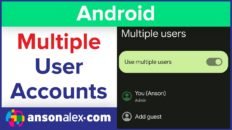Learning how to use Android can be a challenge at first. This is especially true if you’re coming from an iPhone or device running another operating system.
The above video tutorial shows Android and iOS side by side. The idea is to help users learn the similarities and differences between accomplishing different tasks on Android devices and iPhones.
Features covered in the Android for beginners tutorial:
- Tour of the home screen and how to customize it
- Location of Android utilities
- Introduction to the Google Play Store
- Location of phone, contacts and messages
- Looking at wifi, bluetooth, battery and notification settings
- How to access and use Google Assistant
- Information about Google Photos
- Transferring files to and from a computer (Airdroid)
- Sending videos via encrypted messenger
Comparing Android to iOS
Moving from one operating system to another will always take some time and will always come with a learning curve – this is part of the fun if you ask me!
At the end of the day, iOS tends to be more user friendly. One might say that iOS is harder to “break” than Android. You will probably find that apps on iOS are more reliable, altering system settings will not greatly effect your overall experience and that iOS has a nicer aesthetic feel to the user interface.
That being said, Android comes with a slew of advantages as well. The Android operating system, as a whole, is much more customizable than iOS. Uses can remove Infrequently used apps from the Android home screen. At the same time, users can add widgets for different apps to the home screen. These are two things that cannot be accomplished on iOS.
Apple App Store vs. Google Play Store
It is also easier for developers to have their apps approved for the Google Play Store than for the Apple App Store. This means two things:
- Android has a greater variety when it comes to app selection.
- The overall quality of apps available is higher in the App Store than in the Play Store.
When you consider these two points, it is essentially a wash when one compares the two different apps stores – they each have their own advantages.
Switching from iOS to Android
As a Mac user, I find that switching over to Android poses few compatibility challenges. I can backup my phone, transfer files and store photos just as easy with my Android as I can with my iPhone.
Users coming from iPhones may find some initial frustration when it comes to sharing photos and videos with other iPhone users. iMessage is not available on Android so carriers (Verizon, AT&T, Sprint, etc.) may strip out and compress video files being sent by text message between iOS and Android devices. This can be easily avoided by using a dedicated SMS app such as WhatsApp or Kik but can pose problems for users initially.
If you like the idea of completely customizing your device – changing the way basic features look and function – then Android is definitely the operating system for you.
In conclusion, you can accomplish the most of same tasks on Android as you can on iPhone. Although, some of the methods for doing so may be different. Android does features some additional capabilities – simply because developers have more freedom when programming for Android.



